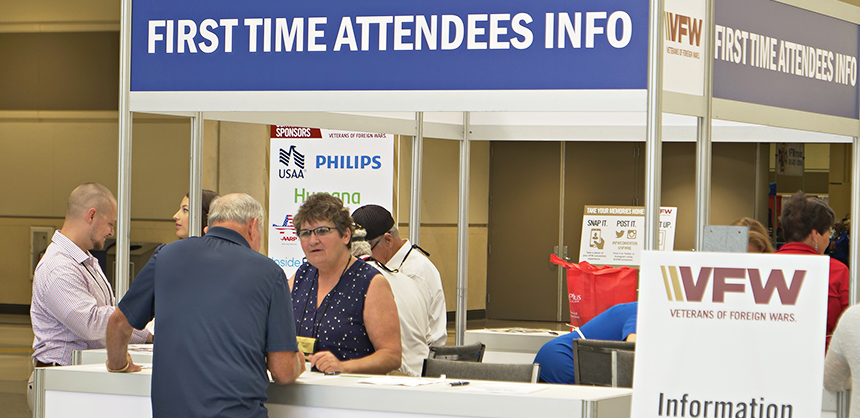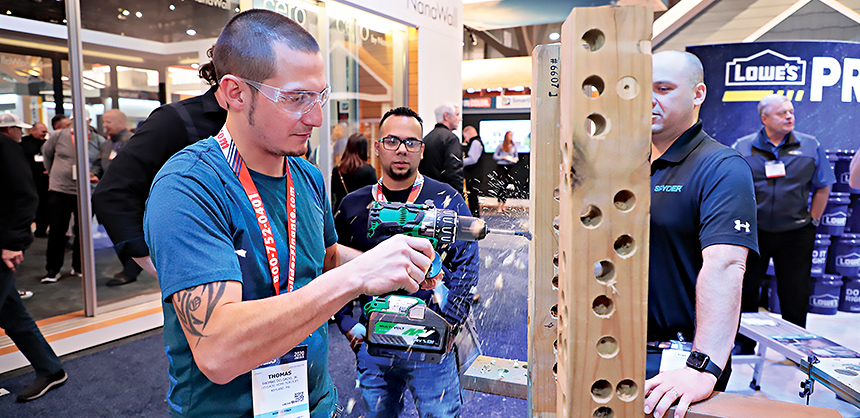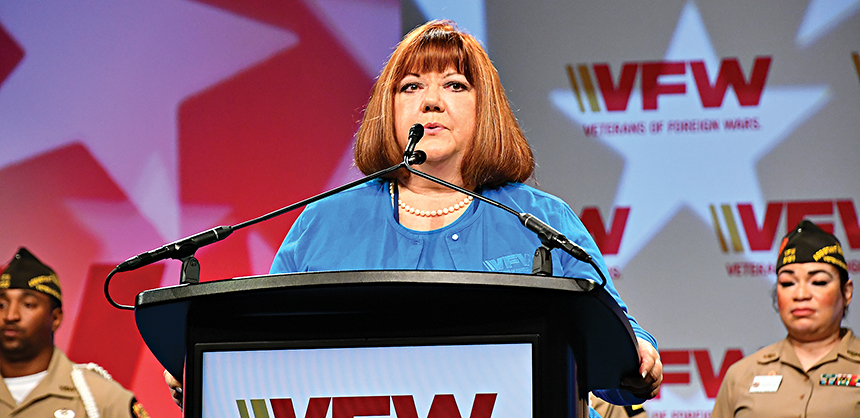A Numbers GameNovember 18, 2021
Successful Conventions Must Keep Attracting New Attendees By Patrick SimmsA Numbers Game
Successful Conventions Must Keep Attracting New Attendees
The National Association of Home Builders 2020 International Builders’ Show (IBS) in Las Vegas. On average, 55% to 60% of attendees are new or first-time attendees to the event.
Regular attendees are the “bread and butter” of any convention. Their consistent participation keeps attendance numbers where they need to be each year, and they can even become resources and advocates for the event. But each one of these familiar faces was once a new face — a first-time attendee. Clearly, the value of attending at one point became apparent to them, and they subsequently had a positive first experience at the convention.
Event organizers can help on both fronts: They can market the convention such that its value proposition is clear to potential first-timers, whether those individuals are members or non-members. And planners can take certain measures to ensure the first-time convention experience is as efficient and rewarding as it can be. These initiatives are important insofar as drawing and accommodating new attendees is crucial to the growth of any convention.
Occasionally, economic, industry or other conditions result in more new attendees than usual, without the aid of targeted promotions. That has been the case with some conventions held since the pandemic began, observes Phelps R. Hope, CMP, senior vice president, meetings & expositions, Kellen Company. “We’ve managed over three dozen in-person conferences [this year], and in about 60% of those conferences, we exceeded 2019 attendance records. And of that increased attendance, there was up to 30% of unique first-time attendees from those who had been members for years. So that is an early indication that we may be attracting first-time attendees from an existing membership base, which is great news,” he says. There are many possible reasons for this “natural first-time attendee wave,” he adds. “Was there a competing scheduling issue that went away, so that’s why they were able to come this time? Or has the company or entity they work for got a renewed marketing or sales push that [meant] they needed to be there? Have people been elevated into positions in their own organizations because of COVID and layoffs, and now it’s a role [that requires them to] come?”

First-time attendees to the annual VFW National Convention get attention from a booth set up just for them. The booth is one of many activities event organizers use to ensure first-timers get the most from the event. Courtesy of Vanessa Kane
Take All Factors Into Account
If organizational changes brought about by the pandemic are behind the surge, planners should take that factor into account as they design upcoming conventions and make them more accommodating to the new attendee. Of course, conventions that routinely see a high percentage of first-timers will likely already be prepared with the right programs. One example is the National Association of Home Builders (NAHB) International Builders’ Show (IBS). According to John McGeary, SVP, business development & brand strategy, NAHB, “On average, 55% to 60% of the IBS attendees are new, with programs in place to help new attendees [pricing, navigation, etc.] at the show.” Those programs are apparently proving effective: “We experienced a 5% increase in second-year retention [2019 to 2020],” he says.
The pandemic has also resulted in a new attendee wave for a different reason: When virtual conventions replaced in-person conventions, the format change drew many that had never attended the convention due to a lack of time or budget for traveling. One example of a convention that saw first-time attendance for this reason is the American Library Association (ALA) Annual Conference. “With an average of 18,000 to 20,000 for our summer conference, and 5,000 to 6,000 for our winter conference, much of the library industry is aware of the benefits of attending. We have found that barriers to attendance typically did not include lack of interest or awareness; many of our first-time attendees report always wanting to attend a conference, but time off from work or limited budgets for travel/lodging prevented them in the past from attending,” says Donna Hunter, conference marketing specialist with ALA. “We have noticed an increase in new attendees with our virtual conferences. Since the pandemic, we have produced three virtual conferences, with a 20% to 40% average of first-timers.”
While there are exceptions, planners must in general be proactive to drive an increase in new attendees. They must broadcast the convention’s value proposition to as many potential attendees as possible, and that requires using diverse marketing channels that reach both members and non-members. Hunter’s team takes that multi-pronged approach to marketing the ALA Annual Conference. “Promotion for our on-site conferences includes a dedicated conference website, an email campaign, social media with healthy engagement . . . and a local planning committee in our host cities to assemble tours and provide additional promotion support,” she says. The digital marketing initiative in particular has greatly diversified. “Since our implementation of virtual offerings, we have focused more on digital marketing, and are beginning to phase into content marketing objectives, such as influencer marketing [i.e., speakers and education presenters]; outreach and tailored resources for exhibitors and publishers, as well as ALA member leaders; segmented and personalized eblasts; customized website landing pages; promotion partners, including state library associations; and vigorous social media. We’re extremely lucky that we have an active following on our social media channels. Our engagement, although slightly quieter during the pandemic, has allowed us to remain connected to our community.”

At the NAHB IBS event, activities are created specifically for first-time attendees as part of an effort to ensure they learn, network with peers and have a positive experience. © Oscar Einzig Photography
Team Up With The Locals
Partnering with the local CVB and targeting promotion to the local community can be a fruitful approach to reaching non-members. “Our National Convention is primarily promoted through our internal electronic newsletters and on our website, often using a microsite designed by the convention city. I depend heavily on partnering with the city CVB to provide that information for our potential attendees,” says Vanessa Kane, CMP, CMM, director, meetings & events/exhibits, Veterans of Foreign Wars of the United States. “In addition, the VFW has utilized Geo Fencing in recent convention cities. We target an approximate 100- to 150-mile radius from the convention city utilizing data [anonymously] from various mobile applications that may serve to identify individuals as potential members, and directing them to the VFW website for membership.”
While e-marketing channels may have risen to the fore, print marketing is certainly still part of the arsenal. For example, Kane’s team also promotes the convention through VFW Magazine, and NAHB similarly markets via a specialized magazine. “Our audience embraces print,” McGeary says. “We just formed a relationship with Professional Builder magazine, the official publication for NAHB. So we partner with them to promote the show. We also have ads in Professional Remodeler magazine.”
In general, it’s critical to use the marketing channels that are most appropriate to the demographic of potential attendees. “We base all of our marketing on the profile of the member. Are these plumbers, carpenters, door installers? Are they working out of a truck? Are they on the road or in the house running their small business? Or are these doctors working in an office? Who are they and how do they receive communication?” He gives the example of reaching doctors specifically: “Good luck trying to find doctors on LinkedIn; they’re not interested. They get in their medical network and that’s where they live. So you have to break through into that network. How do we do that? Well, often there are administrators and often we do mailings. They may have their own intranet that we need to be plugged into.”
Once the ideal communication channels are identified, a value proposition that appeals to first-timers must be formulated. Apart from the general benefits of attending — the opportunities for education, networking and commerce — it is helpful to highlight features of the event that will catch the attention of first-timers in particular. The New Product Zone, a new addition to the NAHB International Builders’ Show, is a case in point. “This is a place on the show floor where a new attendee can come in and see what all the latest and greatest products are in one designated place,” McGeary says. “The exhibitors can put a product in the zone that represents something new and exciting that comes from their company. It creates a more efficient process for a new attendee to experience the show floor.”

Vanessa Kane, CMP, CMM, director, meetings &
events/exhibits, Veterans of Foreign Wars of the United States, at the recent National Convention. The VFW has seen the number of first-time attendees steadily increase. Courtesy of Vanessa Kane
Keep The Messaging Basic
At the same time, the promotional focus when it comes to first-timers should not necessarily be on what’s new at the convention this year, unless the new feature has special relevance to them, e.g., the NAHB’s New Product Zone. “For the potential first-time attendee, we make sure [the messaging is] very straightforward,” Hope says. “This helps them form their own reason as to why they want to attend, and they can communicate it to bosses, spouses, co-workers, etc., and help justify why it makes sense to them to come to this conference.” In contrast, messaging to the regular attendee would emphasize new elements, since they’re already familiar with the basic value proposition.
Naturally, an association has more information about the potential first-time attendee member vs. nonmember. With more details about that individual’s interests, a more targeted value proposition can be conveyed. “If we know a little more about that first-timer, for example if we know they’re a remodeler, we can kind of guide them to the things that remodelers want to experience,” McGeary says. “We have a networking place called the Remodelers Central, where they can network with other remodelers and also get free advice and attend sessions in that room geared toward remodeling. We do that in various other areas as well: 55+ housing, custom building, multifamily housing. So we try as best we can to break down the experience and how it would apply to them.”
And it doesn’t hurt to offer a financial incentive to the prospective first-time attendee. “We offer [new members] an extreme discount: it’s only $150 to gain access to the show and entire education, where typically that investment is $350 to $600,” McGeary says. “Once we get that attendee through the door, there’s a good chance of us getting them back.”
Attendees who have had a successful first-time experience can be another marketing resource: Their testimonials can encourage other first-timers. “We have included messaging from several first-time attendees with their reasons for registering for the conference on our website and in eblasts,” Hunter says. Sometimes that messaging can be captured live from a new attendee at the convention. “We’re fortunate enough to have an on-site video production team. Whenever we hear of a new attendee having a great experience, we try and get them in touch with our team so that they can let us know about it and we can get them on video,” McGeary says. The testimonials are then posted on the NAHB website or social media. With the testimonials, “we try to project diversification in our membership. It’s a goal for us to get the young professional group involved, and all walks of life basically, whether they’re a contractor, a designer, a real estate agent, mortgage broker, etc.,” he adds.
Of course, the content of the testimonial is as important as the source, and not all attendees will express something of substance or promotional value. “We try to feature testimonials that speak to the value proposition of the conference. We want specifics,” Hope says. “So rather than ‘I attended and had a really good time,’ we prefer, ‘I met five new buyers;’ or ‘I learned A, B and C’ or ‘I got to experience this new technology.’ So, we make the testimonials very targeted toward one of the three pillars: networking, education and commerce.” He adds that post-event surveys can help attendees form their opinion about the event, and in turn, be able to deliver a substantive testimonial. “We look at every attendee as the salesperson for the next attendance, and so we give them the tools and communications to be able to share that [messaging].”

First-time attendees to the annual VFW National Convention get attention from a booth set up just for them. The booth is one of many activities event organizers use to ensure first-timers get the most from the event. Courtesy of Vanessa Kane
Optimize The Experience
Drawing new attendees is only the first stage of the process; they must also be converted to regular attendees. It is unlikely that will happen if their first experience at the convention leaves something to be desired. Planners can optimize that experience in many ways, such as:
- Convention guidebooks — New attendees will feel more comfortable with a resource that clearly lays out everything from the schedule to the venue floor plan, to the emergency contacts. “For our on-site conferences, we provide a 200- to 300-page Program and Exhibit Directory. It includes a wealth of information on education sessions, speakers, social events, exhibitors and evergreen information that all attendees find extremely helpful,” Hunter says. “The directory is available in print, as well as digitally, on the conference website. There is also a mobile app that participants can use to navigate the event and make connections with other attendees.”
- First-timer ribbons — These allow first-timers to recognize each other, as well as regular attendees, for networking purposes. “ALA provides an array of fun badge ribbons [e.g., First-Time Attendee, ALA Member, International Attendee, Library Super Hero, etc.], at our on-site and virtual conferences,” Hunter says. “On-site, the ribbons are attached to the attendee badges to wear during the event, while during our virtual conferences, the ‘ribbons’ are attached to the attendee profiles and are visible when attendees participate in various activities.”
- Orientation — Also adding to the comfort level for first-timers is the orientation session. “We hold a reception on the first day in our general session hall for all first-time attendees with an orientation on the convention and how to get the best benefits from attending,” Kane says. “This includes identification of key staff members who can assist to make their first time experience a memorable one.” Hope has also found it useful to stage a videoconference ahead of the in-person meeting that can include senior representatives of the association in discussion with new attendees. “But the onus is on the first-time attendee to be curious on their own. They’re the ones investing the time and money, so the assumption is they’re very curious about what is going on. We just want to make sure we’re getting them the information and giving them a forum if they do need a little handholding,” he explains.
- Ambassador/mentor program — The most personalized form of first-time attendee support is a program that pairs them with experienced attendees who can help them get the most out of their experience. “At our on-site conferences, ALA’s New Members Round Table points first-time attendees to ambassadors [ALA staff and veteran attendees] to answer any questions, provide convention site tours and host networking events [e.g., dinners, library tours and other events in local establishments in the host city],” Hunter says.
The ambassadors in the programs Hope has run are usually past board members or committee chairs, “someone who has been in a leadership role or is a heavy influencer, so that they can then be the networking connectivity person,” he says. “About 80% of first-time attendees like to have [a mentor]. We do the matchmaking and connect them ahead of time via email. We give the mentor an outline of what we’d like them to do: have coffee with [the first-timer], introduce them to five other influencers, etc.”
Similar to the ambassador idea, Kane’s team “instituted a few years ago a ‘First-Timers Booth’ that was placed in a key location [where attendees enter the convention facility] staffed during the convention by local VFW members with the responsibility of acting as a ‘welcome committee’ for first-time attendees.”
Aside from these special measures, most conventions will deliver enough value for the first-time attendee in terms of education, networking and commerce opportunities to warrant repeat visits. Ironically, the challenge for first-timers often is navigating a slew of such opportunities on-site. Planners should bear this in mind when designing messaging to that segment. “We try to not overwhelm them: In your first year of attending, here are the top four or five things you’re going to want to experience — instead of 10 to 15,” McGeary says. First-timers can then gradually experience the full breadth of opportunities at the convention over several installments, and in the process become regular attendees. | AC&F |








